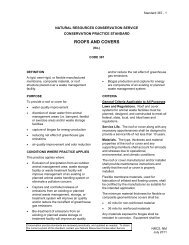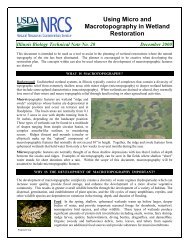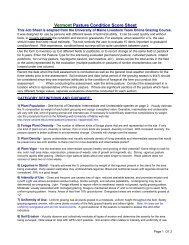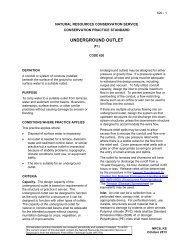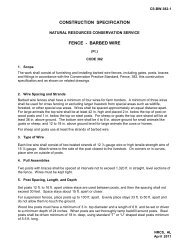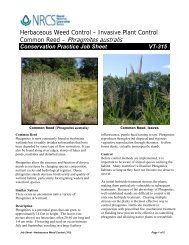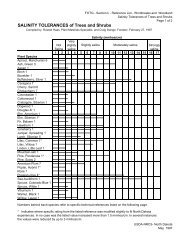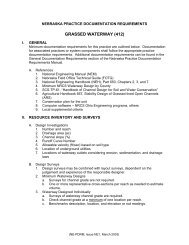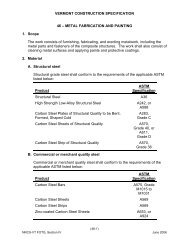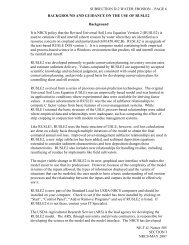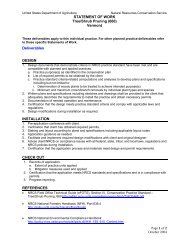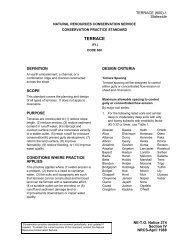The Use of Native Warm Season Grasses for Critical Area Stabilization
The Use of Native Warm Season Grasses for Critical Area Stabilization
The Use of Native Warm Season Grasses for Critical Area Stabilization
You also want an ePaper? Increase the reach of your titles
YUMPU automatically turns print PDFs into web optimized ePapers that Google loves.
wattles. Cape per<strong>for</strong>med well <strong>for</strong> a few years until the willows eventuallydominated. This combination stabilized the slope by creating a favorablemicroclimate <strong>for</strong> seed recruitment from the adjacent native trees and.4. Soil bioengineering, tidal stream, Wells, ME, Plant Hardiness Zone 5.Emergency Watershed Protection planting in June 1993 following severe springflooding. Bank erosion within 8 ft from house foundations. Combination planting<strong>of</strong> ‘Streamco’ purpleosier willow, ‘Bankers’ dwarf willow [Salix cottetii Jos. Kern],and ‘Cape’ American beachgrass were planted. Cape provided initial stabilizationthen was crowded out by willows. Homeowners expectations were exceeded bythe results <strong>of</strong> the planting which were preferable to rip-rap to the top <strong>of</strong> the bank.5. <strong>Warm</strong> season grass cover <strong>for</strong> landfill reclamation at Roxbury and Williston VT,and Cortland, NY, using mixtures <strong>of</strong> ‘Shelter’ switchgrass, ‘Niagara’ big bluestem,‘Atlantic’ coastal panicgrass, ‘Bend’ sand lovegrass, and ‘Osage’ or ‘Rumsey’Indiangrass. <strong>The</strong>se sites have soils with low percent <strong>of</strong> fines, droughty capmaterials, especially in eastern NY and New England. <strong>The</strong> major obstacle tousing warm season mix was the relatively slow establishment and the resultingpossibility <strong>of</strong> erosion during the first summer. ‘Atlantic’ and ‘Bend’ provideimproved establishment during this process, then they are dominated by theother species over time. Due to winter injury, ‘Atlantic’ is only reliable <strong>for</strong> the first2 years in NY and northern New England. Other landfill sites such as Fresh Killson Staten Island and Pelham Bay in the Bronx are now using this approach toprovide long-term, low maintenance, high value wildlife cover.6. <strong>Warm</strong> season grass seeding at the East Corinth landfill in eastern Vermont.<strong>The</strong> native grass seed was tracked in with a dozer. Seeding was a success, butengineers insisted that the site had to be mowed. <strong>The</strong> cover struggled undermowing but has become well established since mowing was abandoned as amaintenance strategy.7. <strong>The</strong> Elizabeth copper mine tailings site in central Vermont. <strong>The</strong> site was bareand highly erosive <strong>for</strong> 40 years with no native plant establishment except <strong>for</strong>broadleaved cattail [Typha latifolia L.] in a wet spot. Plantings <strong>of</strong> warm seasongrass plots in 1988 demonstrated the ability <strong>of</strong> the major species to tolerate theheavy metal concentrations and low pH at the site. A light lime (1000 lbs ac -1 )and fertilizer application (40 lbs ac -1 ) was made at planting and tracked in withthe seed. No soil was applied to the site.8. A titanium and iron mine in Tahawas, NY (eastern Adirondacks) Zone 4, 1500ft elevation. <strong>Warm</strong> season grass mix, 1000 lbs. <strong>of</strong> lime and 80 lbs. <strong>of</strong> N-P-K wereapplied per acre, then tracked in with a dozer.9. Sand bluestem is not native to the Northeast. Like sand lovegrass it is veryuseful in mixes destined <strong>for</strong> use on droughty, low-fines sites. ‘Goldstrike’ sand



